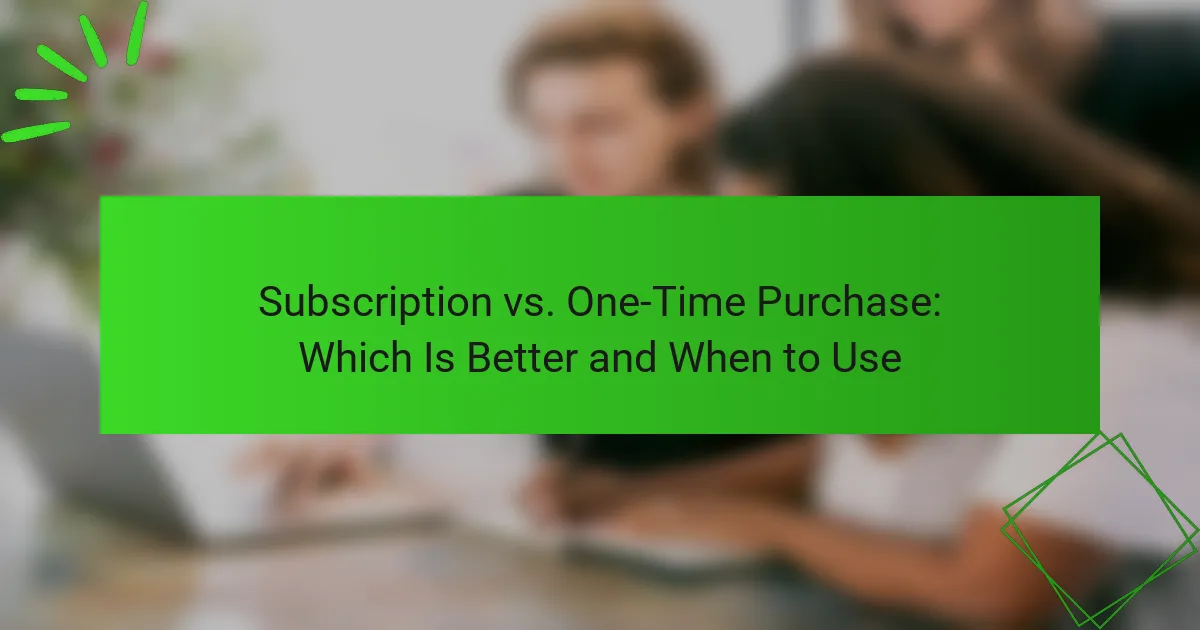When deciding between subscription models and one-time purchases for digital products, it’s essential to weigh the benefits of each approach. Subscriptions offer flexibility, continuous updates, and lower initial costs, making them ideal for users who need ongoing access and support. In contrast, one-time purchases provide full ownership and eliminate ongoing financial commitments, appealing to those who prefer a straightforward payment structure. Understanding your needs can help determine which option is better suited for you.

What are the advantages of subscription models for digital products in Canada?
Subscription models for digital products in Canada offer several advantages, including lower upfront costs, continuous updates, and enhanced customer support. These benefits can make subscriptions a more appealing option for consumers looking for flexibility and ongoing value.
Lower upfront costs
One of the primary advantages of subscription models is the reduced initial financial commitment. Instead of paying a large sum upfront, users typically pay a smaller monthly or annual fee, making it easier to budget. For example, a software subscription might cost around CAD 10-30 per month, compared to a one-time purchase that could exceed CAD 300.
This lower barrier to entry allows users to access high-quality digital products without significant financial risk, making it easier to try new services or tools.
Access to continuous updates
Subscription models often include regular updates and new features at no additional cost. This means users benefit from the latest improvements and security patches, ensuring their software remains current and effective. For instance, a subscription to a graphic design tool might provide new templates or features every few months.
This ongoing access helps users stay competitive and can enhance their overall experience with the product.
Flexibility in usage
Subscriptions typically offer greater flexibility in terms of usage. Users can often choose to cancel or modify their subscription based on their needs, allowing for a more tailored experience. For example, if a user only needs a service for a short period, they can subscribe for a month and then cancel.
This adaptability is particularly beneficial for freelancers or businesses with fluctuating demands, as it allows them to scale their usage without long-term commitments.
Enhanced customer support
Many subscription services provide dedicated customer support as part of the package. This can include access to live chat, email support, or even one-on-one consultations, which can be invaluable for users needing assistance. For example, a subscription to a project management tool might offer priority support for subscribers, ensuring quicker resolution of issues.
Having reliable support can significantly enhance the user experience and reduce frustration when encountering technical difficulties.
Community engagement opportunities
Subscription models often foster a sense of community among users. Many services offer forums, webinars, or exclusive content that encourages interaction and knowledge sharing. For instance, a subscription to an online learning platform might include access to a community of learners and instructors, providing networking opportunities and collaborative learning.
Engaging with a community can enhance the value of a subscription, as users can share tips, ask questions, and learn from one another, creating a richer experience overall.

What are the benefits of one-time purchases for digital products?
One-time purchases for digital products offer distinct advantages, primarily centered around ownership and cost management. Users pay a single fee, gaining full access to the product without ongoing financial commitments.
Full ownership of the product
With a one-time purchase, you own the digital product outright. This means you can use it indefinitely without worrying about subscription expiration or loss of access. Ownership also often includes the right to use the product across multiple devices, depending on the licensing agreement.
For example, if you buy a software application, you can install it on your computer and retain access even if the company changes its pricing model or discontinues the service.
No recurring payments
One-time purchases eliminate the need for ongoing payments, which can be a significant advantage for budget-conscious consumers. Instead of committing to monthly or annual fees, you make a single investment, allowing for better financial planning.
This is particularly beneficial for individuals who prefer to avoid subscription fatigue, where multiple small payments can add up over time, leading to unexpected expenses.
Simple purchasing process
The purchasing process for one-time products is typically straightforward. You select the product, make your payment, and gain immediate access without needing to create an account or manage a subscription.
This simplicity appeals to many users who prefer a quick and hassle-free transaction, especially for digital goods like eBooks or software that can be downloaded instantly.
Potential for long-term savings
In many cases, one-time purchases can lead to long-term savings compared to subscriptions. While the upfront cost may be higher, avoiding recurring fees can result in lower overall spending over time.
For instance, if a subscription service costs $10 per month, that totals $120 annually. If a similar product is available for a one-time purchase of $80, you save $40 in the first year alone, not accounting for potential future price increases in subscription fees.

When should you choose a subscription over a one-time purchase?
Choosing a subscription over a one-time purchase is ideal when you need ongoing access to a product or service that frequently updates or requires regular use. Subscriptions often provide better budgeting options and allow for trial periods, making them suitable for consumers who want flexibility and lower upfront costs.
Frequent updates are needed
If a product or service undergoes regular updates, a subscription model is often the best choice. This is common in software, streaming services, and online platforms where features, content, or security enhancements are continuously rolled out. Subscribing ensures you always have access to the latest version without needing to make additional purchases.
For example, software like Adobe Creative Cloud offers ongoing updates that keep users current with the latest tools and features, which is essential for professionals in creative fields.
Budgeting for ongoing costs
Subscriptions can help manage ongoing costs by spreading payments over time, making budgeting easier. Instead of a large upfront expense, you might pay a smaller monthly fee, which can fit more comfortably into your budget. This is particularly beneficial for services like gym memberships or streaming platforms.
Consider that many subscriptions offer tiered pricing, allowing you to choose a plan that aligns with your financial situation. For instance, a basic streaming service may cost around $10 per month, while premium options could be $15 or more, depending on the features offered.
Trial before commitment
Many subscription services offer trial periods, allowing you to test the product before fully committing. This is advantageous for consumers who want to evaluate the value and functionality of a service without a significant financial commitment. Trials typically last from a week to a month.
For instance, software companies often provide free trials for their products, enabling users to assess usability and features. This approach minimizes the risk of investing in a service that may not meet your needs.

When is a one-time purchase more beneficial?
A one-time purchase is more beneficial when you expect limited use of a product or service, prefer ownership, and want stable pricing over time. This approach can save money in the long run, especially for items that do not require ongoing updates or subscriptions.
Limited use expected
If you anticipate using a product infrequently, a one-time purchase is often the better choice. For example, if you only need a software tool for a specific project, paying once for a license may be more economical than subscribing for a month or year.
Consider your usage patterns carefully. If you find yourself using an item only a few times a year, the cost of a subscription can quickly exceed the price of a one-time purchase.
Preference for ownership
Many consumers prefer to own their products outright rather than pay for access. A one-time purchase allows you to have full control over the item, including the ability to use it indefinitely without ongoing fees.
This is particularly relevant for physical goods like books or tools, where ownership can provide a sense of value and permanence that a subscription model lacks.
Stable pricing over time
One-time purchases generally offer predictable costs, as you pay a fixed amount upfront. This can be advantageous in budgeting, especially if you are concerned about potential price increases associated with subscription services.
For instance, if a software subscription costs $10 per month, over a year, it totals $120. In contrast, if you can buy the software for $100, you save money and avoid future price hikes.

What factors should you consider when deciding between subscription and one-time purchase?
When deciding between a subscription and a one-time purchase, consider your budget, usage frequency, and the value you expect from the product or service. Subscriptions often provide ongoing access and updates, while one-time purchases offer full ownership without recurring costs.
Cost Implications
The cost structure is a primary factor in choosing between subscription and one-time purchase. Subscriptions typically involve lower upfront costs but can add up over time, potentially exceeding the price of a one-time purchase if used long-term. For example, a monthly subscription of $10 can total $120 in a year, while a one-time purchase might be $100.
Evaluate your financial situation and how often you plan to use the product. If you anticipate infrequent use, a one-time purchase may be more economical. Conversely, if you need regular access, a subscription could be more budget-friendly.
Usage Frequency
Your usage frequency significantly influences the decision. For products or services you use daily or weekly, subscriptions can provide ongoing value and convenience. For instance, streaming services are ideal for regular viewers, while software tools may be better suited for occasional users as one-time purchases.
Consider how often you will engage with the product. If it’s a seasonal need or a one-off project, a one-time purchase is likely the better choice. For ongoing needs, subscriptions can offer flexibility and continuous updates.
Value Over Time
Assess the long-term value of the product or service. Subscriptions often include additional features, updates, and support that enhance their value over time. For example, software subscriptions frequently provide the latest versions and security updates, which can justify the recurring cost.
On the other hand, if the one-time purchase meets your needs without the necessity for updates or additional features, it may be the more sensible option. Always consider how the value proposition aligns with your usage and expectations.










